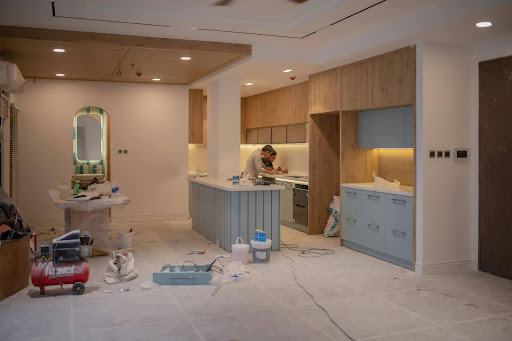The worst nightmare for a real estate investor in the middle of a rehab or fix-and-flip deal is to run out of money in the middle of the process. They end up stuck with an unlivable, half-finished property, carrying the costs of insurance, property taxes, and debt service with no profit in sight … and all the while the looming spectre of a downturn in the market could put them at a loss.
If this nightmare becomes a reality, fast access to working capital loans can be a crucial lifeline. It can help you cover unexpected costs, stay on schedule, and save the deal. But strict rules apply to financing real estate deals with business debt. Is this a viable strategy? What risks and downsides do the investor incur by assuming more debt, and how can those risks be managed?
Munoz Ghezlan Capital has helped rehab and fix-and-flip investors raise up to $500,000 on short notice from working capital loans for short-term project financing to get them through tight spots. Let’s examine what these loans are good for, what they’re not good for, what to look out for, and when to contact a Munoz Ghezlan Capital specialist to ask crucial questions and get the ball rolling.
Understanding Rehab and Fix-and-Flip Economics
Real estate investors rehab property for a variety of reasons. Buy-and-hold investors may rehab a distressed or outdated unit so that it can command more rent or be put to a different use.
Fix-and-flip investors buy distressed or outdated properties to renovate and then sell for top dollar. To turn a profit, they must typically buy the property at well below the ARV (after-repair value) and account for rehab and carrying costs when computing their profit potential.
In either case, time is not your friend when rehabbing an investment property. As long as the dwelling or commercial space is under renovation, it cannot produce rental income or sell for anywhere close to the ARV. Moreover, an unoccupied unit is not just inert — it’s an active cash drain. The owner-investor must pay for property taxes, insurance, utilities, debt service, and other expenses whether someone lives there or not; whether work is stalled or not.
If the investor runs out of money for the rehab or the project gets delayed, the investor is on the hook for all of those expenses for a longer period of time. Worse, if the market takes a turn for the worse, that ARV may no longer be attainable, eating into the potential profits and even forcing the investor to take a loss on the entire project.
For that reason, real estate investors typically want their rehab to go as fast as possible, making allowances in their underwriting for possible delays and setting aside enough cash reserves to cover unexpected cost overruns.
What Are Working Capital Loans?
Working capital loans are a kind of business debt intended to furnish companies with the capital they need to accomplish big initiatives, cover recurring expenses, maintain liquidity in the face of uncertain cash flow, or other short-term project financing needs.
Working capital loans fall into two major categories:
- Loans. Lump-sum payments with fixed terms and predictable monthly payments, usually unsecured by collateral and with fixed interest rates.
- Lines of Credit. Revolving debt instruments (similar to credit cards) that the borrower can draw upon at will up to the credit limit for the term of the line of credit — usually one year before a renewal review. They can either be secured or unsecured and usually have variable interest rates.
Working capital loans are given based on revenue, cash flow, time in business, and the creditworthiness of the business. They can also be funded quickly, anywhere from the same day to less than a week if everything is in order.
Some working capital loans are insured, in whole or in part, by the US Small Business Association (SBA), giving lenders the confidence to offer higher loan balances and favorable interest rates.
How Are Working Capital Loans Different from Hard-Money Loans and Bridge Loans?
Many real estate investors rely on hard-money loans or bridge loans to acquire and get working capital for real estate rehab. Here’s what makes these debt instruments distinct:
- Hard-Money Loans. Short-term loans uninsured by Federal mortgage banks (Fannie Mae, Freddie Mac, etc.), with the property as collateral and higher interest rates than traditional mortgages, usually with interest-only payments. Common for fix-and-flip funding. Usually covers a portion of the purchase price and the rehab budget.
- Bridge Loans. Short-term loans, also uninsured by Federal mortgage banks and secured by the property as collateral, with interest-only payments and allowances made for rehab costs. Common for buy-and-hold rehabs, after which the borrower usually gets a long-term loan.
You will notice that both of these debt vehicles use the subject property as collateral. Think of them as short-term mortgages. They are used to either acquire or refinance the property. Working capital loans, on the other hand, often have no collateral. They could include guarantee clauses that empower them to go after the borrower’s assets in the event of default, but no lien is placed against the property to secure the funding.
Both hard-money loans and bridge loans have one thing in common — they often include loan proceeds that are meant to cover the rehab budget. However, you usually don’t get all the rehab money up front. The lender wants to know that you are actually doing the rehab with those proceeds, they will either disburse the funds on a schedule pegged to the project plans, or pay rehab contractor invoices you send them.
Can You Use Working Capital Loans to Fund Rehab and Fix-and-Flip Deals?
It depends on what you are trying to fund. If you want to use the working capital loan to fund the down payment specified on the mortgage note, this is often not allowed.
In the case of conventional residential and commercial mortgages, this is never allowed. Fannie Mae and Freddie Mac don’t allow you to use borrowed funds for your down payment, and many lenders have their own policies against this. Some hard-money and bridge lenders are more lenient, but plenty of them impose similar restrictions. If you try to fool them as to the source of the funds, you could become liable for mortgage fraud.
However, there is no rul against you borrowing money to get working capital for real estate rehab — both the rehab expense itself and the property carrying costs. You can pay contractors, buy materials, float property taxes and insurance, and pay real estate sale expenses from any source you want, including funds borrowed from working capital lenders.
Reasons to Use Working Capital Loans for Rehab and Fix-and-Flip Deals
- Fund the down payment, closing costs, and earnest money deposits (if your lender allows this — not guaranteed).
- Purchase materials and pay laborers to get the rehab underway quickly or move on to the next stage ahead of schedule — even before your hard-money or bridge loan approves the disbursal.
- Absorb unexpected expenses that might arise during demolition (which might be the first time you see the “guts” of your rehab — surprises are the norm!)
- Pay contractors quickly to ensure positive long-term working relationships with them — even if the lender drags its feet.
- Cover carrying costs during any delays in the rehab schedule — property taxes, insurance, debt service, utilities, etc. Construction delays are a fact of life, and smart flippers prepare contingencies for them!
- Finance staging the home and marketing it for sale.
-
Risks and Downsides of Using Working Capital Loans for Rehab and Fix-and-Flip Deals
- Cash Flow Concerns. Some short-term working capital loans, especially those that offer fast funding, may require repayment by weekly or even daily ACH draws instead of monthly payments, creating significant cash flow pressure.
- Loan Stacking Issues. Some lending notes specifically prohibit you from taking on other debt without their explicit permission. More debt in the deal increases the risk for all lenders, as well as for the borrower.
- Over-Leveraging. Investors may find even longer-term loans eating into their cash flow so much that they can’t cover their debt service. Even fix-and-flip investors who overleverage may find themselves owing more than the ARV, wiping out their profit margins.
Requirements and Qualifications for Working Capital Loans
What does it take to qualify for working capital loans? It varies by lender and loan product, but usually you will need to furnish the following:
- Financial statements (profit/loss statements, balance sheets, bank statements, tax returns, etc.) showing revenue, cash flow, and tax records.
- Proof of longevity of the business/years in business.
- Business plan for the use of the funds.
- A business entity (LLC, corporation, etc.) with good business credit.
Depending on the lender, you may also need to verify your personal creditworthiness as with any loan, furnishing:
- An acceptable personal credit score (usually 680, though some lenders accept lower scores).
- Proof of income.
- Acceptable debt-to-income ratio.
When Working Capital Loans Make the Most Sense
Under what circumstances does it make sense to seek a working capital loan for your rehab or fix-and-flip funding? Here are some of the most valid use-cases and indicators for success with such a strategy:
- Projects with Fast Turnaround Times. If you expect your rehab to go quickly, you may not want to wait for the disbursal schedules set by a bridge or hard-money lender, nor go through their validation process for the contractor invoices.
- Projects with High ARV Spreads and Good Comps. If you have a very good idea of the ARV from the comparable properties, and if you secured an acquisition price that leaves you with a sizable profit margin, it may be prudent to take on the risk of extra debt to preserve your dry powder capital for other deals or emergencies.
- Time Bottlenecks. If you have a project where time to completion is the major factor, a working capital loan can be a good solution for covering the carrying costs as you make your way through the bottleneck.
- Experienced Flippers. If you have a proven track record, with reliable contractors and four or more flips per year, you can access better working capital loans with more favorable terms.
Alternatives to Working Capital Loans for Rehab and Fix-and-Flip Deals
Working capital loans can be an excellent source of unsecured funding to help you finish your rehab or fix-and-flip, but it’s not your only option. Other moves to consider include:
- Hard-Money Rehab Loans. Hard-money lenders may include rehab costs in their loans, but you can’t necessarily just go back to them for extra money if something unexpected comes up, and hard-money loans require that the property itself act as collateral.
- A DSCR Loan. A debt-service coverage ratio (DSCR) loan is a loan based on the rental income potential of the loan, in the same way personal loans are often based on your personal income. Many DSCR lenders take into account the potential rental income of your property, even if it is under construction and uninhabitable. However, these loans can take up to 30 days to fund, so if time is of the essence, a working capital loan may be a better option.
- A Cash-Out Refinance or HELOC. You may be able to take out a conventional mortgage or home equity line of credit (HELOC) of the fair-market value of the property, especially if the renovation is near completion. This loan can be used to retire the acquisition debt and put excess cash into the project coffers. However, the underwriting process for a loan like this could take longer than a working capital loan.
- Partner Equity. You could instead take on a partner to fund the renovation or rehab. However, partners will then own part of the equity of the deal, leaving you with a smaller piece of the pie. But bringing on a partner with deep pockets who believes in the deal may get you out of a bind with some fast cash. Plus, partnerships are based on relationships, so you need a strong network of high-net-worth people to have a decent shot at this.
- Private Lender. Private lenders (not banks or hard-money institutions) are a well-loved source of working capital for real estate rehab and funding. Private lenders may be able to fund quickly, but that’s not guaranteed and the interest rates tend to be higher. And like with partner equity, you need a good reputation and a strong, high-net-worth network to source private lenders.
Bottom Line
Working capital loans carry some problems when it comes to acquiring properties for fix-and-flip and rehab deals due to restrictions against borrowed money for down payments. However, if a rehab runs into trouble, or if you want to get your fix-and-flip done as quickly as possible, working capital loans can be a fast, flexible, unsecured source of short-term project financing to get your deal across the finish line.
Munoz Ghezlan helps rehab and fix-and-flip investors secure anywhere from $50,000 to $500,000 in unsecured debt with terms up to 7 years and easy monthly payments, more than enough to close out a rehab or fix and flip with margin to spare.
If you have questions about which debt vehicles are the best choice to maximize your profits, Schedule a meeting with Munoz Ghezlan strategist today. We have helped hundreds of rehabbers and flippers cash out in the green, and we’re committed to making your next rehab or fix-and-flip investment a home run.
















